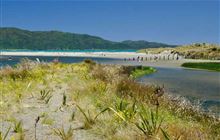Estuarine systems in the lower North Island/Te Ika-a-Māui
Introduction
This report describes geographic features, values and pressures for 48 estuarine sites in the lower North Island and sets out current and potential conservation activities. Published 2016.Download the publication
Estuarine systems in the lower North Island/Te Ika-a-Māui (PDF, 12,870K)
Brochure about the report (PDF, 870K)
Summary
To help with management decisions, each site is also given various scores and rankings.
The report is a practical resource for councils, iwi, environmental groups and interested people.
Estuarine ecosystems, where saltwater meets freshwater, are uncommon ecosystems that are of high value and under increasing pressure from a range of threats.
With the growing awareness of their importance and the need to conserve them, this document has been produced as a resource for all those with an interest in estuarine ecosystems, including conservation managers, landowners, tangata whenua, community groups, resource managers, scientists and recreational users.
A large number of organisations and individuals from these interest groups have contributed valuable knowledge to this document, making it a highly practical resource. It also complements online resources that have been developed to assist community restoration aspirations for estuarine systems around New Zealand.
This document is the first attempt to bring together a large amount of information on the estuarine ecosystems that occur in the lower North Island (Te Ika-a-Māui) of New Zealand. We assess the current state and future potential of 48 sites from the Manawatū river mouth on the west coast to the Waimata river mouth on the eastern Wairarapa coast. We also present a ranking system that was developed to guide decision making about priorities for their ongoing management.
The information within this report was obtained through a combination of site visits (during 2006 and 2009, with some sites revisited in 2015), a literature review and expert/local knowledge. Although the main site visits were undertaken several years prior to the publication of this report, the information is deemed to be current based on expert/local knowledge.
There are four broad types of estuarine systems within the study area that have different physical characteristics and functioning, and consequently varied values and management needs. Each distinct estuarine site is presented as a standalone chapter to be read in conjunction with the introduction and appendices. Each site chapter contains information on the catchment characteristics, land status, significant biota and habitats, as well as maps, comments on recreational values, pressures, and existing management and conservation strategies. Also included are some suggestions for future ecosystem restoration initiatives.
While some information in the report is from recently published reports, much is based on historic literature or expert/local knowledge, and so is qualitative in nature. This is not intended to be a detailed analysis of the information available for each site, but rather to act as a resource for further conversations about these estuarine ecosystems.
The sites range in size from 1 to 870 hectares, with 42% being less than 3 hectares. In total, 58 Threatened and At Risk species were recorded across the 48 estuarine sites: 14 plants, 28 birds, 9 fish, 3 reptiles and 4 invertebrates. The average number at individual sites was 14 (range = 3–35),but 11 sites had more than 20.
As uncommon ecosystems, all estuarine sites (even the small ones) are valuable, particularly as havens for threatened plant species. Nonetheless, the estuarine sites were rated and ranked for conservation and restoration significance using a range of both absolute (number of Threatened/At Risk species present) and assigned (ecosystem, social, restoration potential and pressures) values. No overall ranking was given, however—rather, the information can be used to inform conversations for a range of purposes and at a range of project scales, from single estuarine sites through to regional management. This document also makes no attempt to compare these estuarine sites with other estuarine or similar sites in other parts of New Zealand—all rankings refer strictly to the 48 estuarine sites contained within the study area.
Many, but not all, of the top-ranked estuarine systems are currently being actively managed by agencies. There are 14 coastal restoration groups and 11 groups focusing on catchment restoration. There is also great potential for citizen science at these sites.

